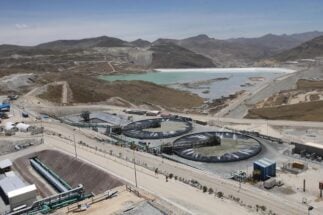The UN Food Systems Summit, which took place in Washington DC last month, couldn’t be faulted for ambition. “The way we produce and market food is harming our environment,” said its website. “This has to change.”
The summit was called by UN Secretary General António Guterres to address the serious impacts of the growing demand for commodities on the world’s ecosystems, as well as the consequences this has for people’s health and wellbeing.
So, it may come as a surprise that campaign groups representing local farming and fishing communities around the world decided to boycott the event, even though it seemed to be ideally suited to further their aims.
Speaking ahead of the event, Elizabeth Mpofu, a member of the International Coordination Committee of La Via Campesina, a global network of peasant organisations, said it would “not only promote corporate interests, but it will also shrink even further the already limited space available for social movements and civil society inside the UN”. A summit spokesperson challenged this, stating: “There is no single business or agribusiness in any part of the Summit process. The Summit was developed by the three food agencies of the UN.”
La Via Campesina, among other groups, has long campaigned for the interests of small-scale farmers and for a trade system that puts the interests, health and welfare of people above profits. It is a deeply emotional issue: many farmers suffer loss, poverty and poor health because of the policies of the big agricultural companies, whose financial and legal muscle can influence markets and effectively, if unintentionally, disenfranchise local communities.
However, these commercial juggernauts are facing pressure to change as an increasingly stringent body of regulations reaches into their operational and management structures, changing the way they do business, manage people, consume resources and treat the environment.
Shareholder pressure
Alejandro Guarin, senior researcher at the International Institute for Environment and Development (IIED), says the pressure for change has shifted. So far, the big agribusinesses have been merely reacting to public scandals, such as the backlash against Monsanto’s genetically modified “terminator seeds”; or the class action lawsuit being launched against Syngenta over its Paraquat herbicide. In July, Bayer pledged to withdraw glyphosate (a herbicide that UN scientists in 2015 classified as “probably carcinogenic to humans”) from retail sale in the US by 2023.
Increasingly, it is shareholders exerting the pressure, Guarin says. Together with activist investors, they are demanding that companies demonstrate their environmental, social and governance (ESG) credentials, either through commitments and actions at the corporate level, the products they offer or the instruments they use for financing. The investment industry has seen a radical shift in the thinking of asset owners, regulators and investors in favour of ESG rules. In practice, this means that more and more investment capital is being channelled into “sustainable” investments, and away from companies where profits come at the cost of the environment or of local farming communities.
A lack of transparency and uniformity in labelling, commitments and reporting has clouded the ESG message
Financial markets have enthusiastically adopted the ESG concept, driving phenomenal growth in the sector. Data from Moody’s Investors Service shows that in the first quarter of this year, a record US$231 billion’s worth of green, social and sustainability bonds were issued, a 19% increase on the previous quarter, and a total over three times higher than the same quarter in 2020. Meanwhile, investors last year poured US$347 billion – also a record – into ESG equity funds, and more than 700 ESG funds launched globally to meet soaring demand. By 2025, Bloomberg Intelligence says, “global ESG assets are on track to exceed US$53 trillion, representing more than a third of the US$140.5 trillion in projected total assets under management”.
Agricultural companies are realising that if they do not implement the new ESG rules, there will be a smaller pool of investment capital available to them to finance their operations.
One reason for the growth in ESG investing is that investors too are under legal and reputational pressure. Nicolas Hardy, executive director at Scope Ratings, said: “For banks, ESG disclosure risks are becoming a source of product liability. This is a good reason to consider ESG integration as a very relevant credit issue. More sophisticated frameworks will introduce more rigid requirements. Fines related to misleading disclosures, product mislabelling and consumer protection may come on top of reputational damage.”
Corporate greenwashing
But as ESG becomes a mainstream reality in financial markets, so has the practice of “greenwashing” – making overstated or misleading claims about ESG compliance. A report from S&P Global Ratings says that the drive for ESG “has led to an inevitable and exponential rise in the volume of green claims made by companies in their attempt to demonstrate sustainability credentials to their stakeholder base”. A lack of transparency and uniformity in instrument labelling, commitments and reporting, the S&P report suggests, has clouded the ESG message and allowed some companies to make questionable, “greenwashed” ESG claims in their marketing. This leaves some investors in doubt about the reliability of the ESG ratings that guide their investment decisions.
The one positive to come out of this confusion is that it has created space for fund managers to launch specialist financial products that properly address the needs of investors who want or need to apply strict ESG criteria to their investments. One such is the new fund manager iClima, which aims to invest in the next generation of companies working on solutions that actively combat global warming and rising emissions.
Gabriela Herculano, co-founder and CEO of iClima, says: “We have analysed solutions such as plant-based dieting and vertical farming. Project Drawdown [a non-profit group focused on climate solutions] has been a key reference for the work we do, and one of their solutions is conservation agriculture, which requires minimum soil disturbance, keeping soil covered and crop rotation. Another agricultural solution is regenerative annual cropping, which excludes the use of pesticides or synthetic fertilisers.”
Of all their research on the agricultural sector, Herculano says: “We have not yet been able to find any listed agriculture companies with proven conservation agriculture or regenerative cropping practices.” She adds that agricultural companies that integrate such methods for ESG purposes would need to offer, as evidence of their commitment, clear indicators of potential avoided emissions, in terms of carbon dioxide equivalent per year, and on water consumption. She adds: “In this sense, a holistic ESG approach must incorporate indicators on how a company deals with key social and employment issues, and how sustainability is dealt with at the board level.”
Aligning ESG practices
One way to dispel doubt and encourage the adoption of ESG practices is to standardise criteria and definitions, and increase the level of disclosure and consistency in reporting. Work is already under way. The EU is developing a number of new regulations, including: the Sustainable Finance Disclosure Regulation (SFDR), which requires asset managers and pension funds to disclose the ESG risk in their investment portfolios; the Corporate Sustainability Reporting Directive, which by 2023 will require companies to declare how their business affects the environment, their employees and customers; the EU Green Bond Standard, which proposes definitions for a “gold standard” of sustainable debt; and the Taxonomy Regulation, effectively a dictionary of terms designed to prevent market participants from gaming the system.
These EU regulations will affect all companies that want to access EU financial markets. As these markets are global by nature, so the regulations will ultimately have a global reach. Analysis by S&P Global suggests that non-EU companies affected by SFDR may together be worth some US$3 trillion in market capitalisation.
Progress is slow, and the pressure is moral, not legal
Standardisation is no silver bullet, however, as there is little independent verification, says Guarin. Work is being carried out in this area by the World Benchmarking Alliance (WBA), but progress is slow, and the pressure is moral, not legal. The WBA last month published its third Access to Seeds Index, which measures and compares the efforts of the world’s leading seed companies to enhance the productivity of smallholder farmers in Asia and Africa. In the past five years, the report says, “the global and regional seed companies are doing much better with availability and suitable crops for smallholder farmers, showing significant progress in providing climate-resilient crops and more diverse seed portfolios.” Guarin adds that it is the biggest companies, those few most in the public eye, that will be making the progress. For the rest, the pressure to comply with ESG is limited.
It is against this tightening regulatory backdrop that the big agricultural companies are now having to operate. In recognition of this new reality, major corporations with agricultural interests, such as Cargill, General Mills, McDonald’s and Starbucks, are working to cut their carbon emissions and meet sustainability targets. They are also participating in initiatives to promote environmentally friendly agriculture, such as the Sustainable Agriculture Initiative, the New Vision for Agriculture and the New Food and Land Use Economy.
For campaigning groups such as La Via Campesina, Friends of the Earth, The Transnational Institute and Crocevia, such initiatives, while well meaning, effectively work with rather than against the large agricultural companies. In their eyes, the Food Systems Summit also falls into this category and is “captured” by corporate interests.
The battle between the big agricultural companies and the local farming and fishing communities goes back decades, but for the agricultural companies, after decades of unbridled growth, it is now in their business interest to go green.








